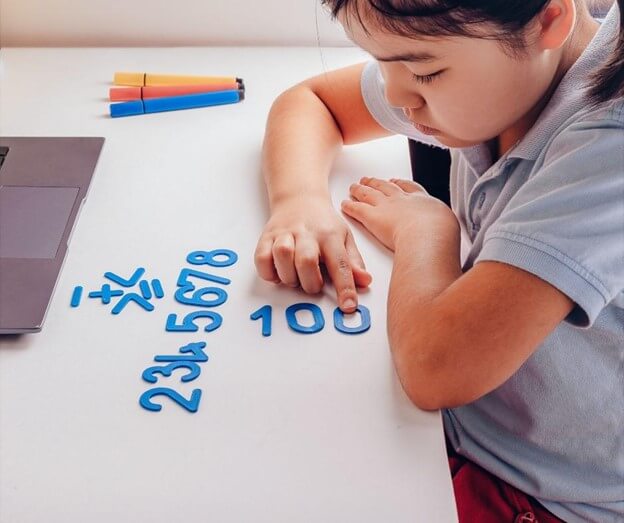Exploring real-life examples of overcoming struggles in primary math
Wiki Article
Unveiling the Finest Faster Ways for Resolving Mathematics Issues Quickly
In the domain of mathematics, effectiveness is vital. Grasping shortcuts can change the way individuals come close to troubles. From leveraging the distributive residential property to using quick multiplication techniques, these strategies improve both rate and accuracy. Additionally, identifying patterns simplifies complicated estimations. As one checks out these techniques, they might reveal shocking insights that can change their mathematical experience. What are one of the most efficient strategies that can be easily integrated right into everyday practice?Grasping Psychological Math Techniques
Exactly how can one improve their calculation speed without counting on calculators? Grasping psychological math methods supplies a sensible remedy. By utilizing strategies such as breaking numbers into smaller sized, manageable components, individuals can simplify intricate computations. For circumstances, when including two-digit numbers, rounding each number to the closest 10 can make mental addition much easier before adjusting back to the initial values.Another reliable approach is to practice reproduction tables thoroughly, allowing quick recall of products (struggles in primary math). Additionally, recognizing patterns in numbers can help with much faster computations, such as using the residential properties of even and strange numbers. Regular practice via video games and challenges can even more improve these skills, making mental math more instinctive
Inevitably, growing self-confidence in one's arithmetic capabilities enables quicker decision-making and boosts total mathematical proficiency. By integrating these strategies, any person can greatly boost their calculation rate.
Utilizing the Distributive Building
The Distributive Property is a fundamental concept in mathematics that simplifies computations by allowing multiplication across enhancement or subtraction. It is necessary for trainees to comprehend its application via practical examples, which can enhance their analytic abilities. Additionally, acknowledging common errors can further solidify their understanding and stop errors in future calculations.Understanding the Distributive Residential Property
Grasping the distributive home can considerably simplify mathematical computations. This basic residential property states that when increasing a single term by a sum or difference, one can disperse the reproduction across each term within the parentheses. In the expression a(b + c), one can reword it as abdominal + a/c. This technique not only simplifies calculations yet also enhances understanding of just how numbers connect (struggles in primary math). The distributive property is especially beneficial in algebra, where it aids in streamlining expressions and resolving equations. Additionally, it prepares for a lot more intricate ideas, such as factoring and polynomial procedures. By understanding the distributive property, trainees can develop a strong foundation for tackling a vast array of mathematical obstacles efficientlyPractical Examples Illustrated
Why is it essential to use the distributive residential property in sensible scenarios? The distributive building enables individuals to streamline complicated computations, making problem-solving more efficient. As an example, when computing the overall cost of several products, one can make use of the expression 5(2 + 3) to discover the overall price of 5 items priced at $2 and $3. By dispersing, the computation ends up being 5 × 2 + 5 × 3, yielding a quicker outcome of $25. An additional example is in algebra, where streamlining expressions like 3(x + 4) can be attained with circulation, leading to 3x + 12. Such applications show the efficiency of this residential or commercial property in different real-world situations, improving both rate and precision in mathematical problem-solving.Usual Blunders to Prevent
Although the distributive home is a powerful tool in maths, common mistakes can cause wrong results. When pupils forget to distribute the coefficient to each term within parentheses, one constant error takes place. In the expression 3(x + 4), stopping working to apply the building correctly can lead to omitting the multiplication, producing an inaccurate solution. One more mistake involves defalcating the residential or commercial property by including as opposed to increasing, especially when adverse indications are entailed. Additionally, pupils may forget to simplify the outcome, which can unknown mistakes made during distribution. Recognizing and avoiding these challenges can enhance analytical efficiency and precision when using the distributive building in various mathematical contexts.Quick Multiplication Shortcuts
In the domain of fast reproduction shortcuts, strategies like increasing by powers of 10 and the increasing and halving method stand out. These methods can significantly streamline estimations, making them a lot more obtainable. Understanding these shortcuts can boost effectiveness in mathematical problem-solving.Increasing by Powers of 10
When increasing by powers of 10, the procedure becomes remarkably uncomplicated, as the procedure largely involves shifting the decimal factor. Multiplying a number by 10 calls for relocating the decimal one place to the right, while multiplying by 100 necessitates a change of two places. This simpleness reaches bigger powers, where each added zero indicates one more decimal shift. Increasing 5.6 by 1,000 outcomes in 5,600. This approach substantially boosts rate and precision, as people can swiftly imagine the result without complicated calculations. Such efficiency is particularly advantageous in psychological mathematics or when time is restricted, permitting quick problem-solving in numerous mathematical contexts. Grasping this method is important for anybody intending to boost their arithmetic abilities.Increasing and Halving Technique
The Doubling and Halving Method supplies a reliable method for quick reproduction, specifically when dealing with also numbers. This method includes transforming a reproduction issue into an easier form by either doubling among the numbers and halving the various other. To determine visit our website 16 × 25, one can halve 16 to get 8 and double 25 to obtain 50, resulting in 8 × 50, which equals 400 (struggles in primary math). This technique streamlines estimations, making them much more manageable. It is specifically valuable in psychological math, permitting people to overcome troubles swiftly and properly. By leveraging this method, professionals and pupils can improve their numerical dexterity, consequently boosting general performance in mathematical tasks
Efficient Department Strategies
Although department frequently poses obstacles for lots of students, utilizing effective methods can considerably simplify the procedure. One reliable approach is making use of suitable numbers, which entails rounding the divisor and returns to simpler values that are close to the initial numbers. This method makes psychological calculations more workable. An additional strategy is the estimate strategy, where students can find a rough solution before performing the exact department, offering a useful benchmark for accuracy.
Additionally, the long division technique continues to be a staple for separating bigger numbers. By breaking the procedure right into smaller, a lot more absorbable actions, students can preserve clearness. The duplicated reduction approach can likewise be handy, specifically for those that have a hard time with more abstract principles. By systematically subtracting the divisor from the dividend, individuals can visualize the process. Overall, these methods can boost department abilities, leading to quicker and more precise analytic capabilities.
Rapid Addition and Reduction Methods
Just how can learners improve their rate and accuracy on top of that and subtraction? One reliable approach is to use psychological mathematics methods, such as breaking numbers right into smaller, much more manageable parts. For example, when adding 47 and 36, one can initially include 40 and 30 to get 70, then include the remaining 7 and 6 to get to 83. This technique simplifies calculations and decreases mistakes.Another strategy involves utilizing the number line for visual students, aiding them to see the connections in between numbers and improve their comprehension. Additionally, experimenting devices like flashcards can enhance fast recall of standard amounts and distinctions.
Moreover, students can benefit from acquainting themselves with benchmark numbers, such as rounding to the nearby 10, which enables quicker estimates. By incorporating these techniques right into their method, students can substantially improve their speed and precision in basic arithmetic procedures.
Leveraging Evaluation for Quick Calculations
Evaluation acts as an effective device for improving estimation rate, enhancing mental math approaches effectively. By rounding numbers to their nearest entire worths, people can streamline complex calculations, making it simpler to reach an approximate result quickly. As an example, when faced with a trouble like 198 + 267, rounding to 200 + 270 returns a quick estimate of 470, permitting the solver to assess the accuracy of the last solution.Estimation is particularly useful in scenarios including reproduction and department. By rounding elements to easier numbers, one can swiftly assess approximate products or quotients. This strategy not browse around these guys just saves time however additionally aids in identifying prospective errors in computations.
Acknowledging Patterns and Formulas
Patterns and solutions are vital devices in mathematics that allow people to resolve troubles more successfully. Identifying these patterns enables students to identify connections in between ideas and numbers, which can streamline complicated calculations. Recognizing the square formula (ax ^ 2 + bx + c = 0) helps with fast solutions to numerous formulas.In addition, patterns in turn, such as math or geometric progressions, aid individuals predict future terms without comprehensive estimations. Formulas, on the various other hand, act as shortcuts, permitting for faster problem-solving by enveloping complicated partnerships right into workable expressions.
Frequently Asked Inquiries
How Can I Enhance My Focus While Resolving Math Issues Quickly?
To enhance focus while addressing math troubles quickly, one can eliminate disturbances, set certain goals, method mindfulness strategies, take routine breaks, and maintain a regular research regimen to improve concentration and mental clearness.What Devices or Applications Assist with Quick Math Problem-Solving?
Numerous tools and apps, such as Photomath, Microsoft Mathematics Solver, and Desmos, enhance quick mathematics analytic. These resources supply detailed remedies, graphing capabilities, and instantaneous feedback, making them useful for professionals and pupils alike.Exist Particular Mathematics Shortcuts for Standardized Tests?
Yes, specific mathematics shortcuts for standard examinations consist of methods like estimation, understanding number homes, utilizing the process of elimination, and understanding typical formulas. These methods enhance speed and accuracy, improving general test efficiency.
How Do I Practice Math Shortcuts Efficiently?
To exercise math faster ways efficiently, individuals must routinely solve diverse issues, utilize on the internet here are the findings resources, and take part in timed drills. Consistency and reflection on mistakes improve understanding, ultimately leading to improved rate and accuracy in estimations.Can Shortcuts Be Applied to Complicated Mathematics Issues?
Shortcuts can without a doubt be applied to intricate mathematics issues, although their performance differs. Proficiency of fundamental concepts and calculated reasoning enables individuals to streamline processes, making it less complicated to tackle complex calculations effectively.By using strategies such as damaging numbers right into smaller sized, manageable parts, individuals can simplify complex computations. In addition, acknowledging patterns in numbers can facilitate faster estimations, such as utilizing the homes of also and odd numbers. Estimation offers as an effective tool for enhancing computation speed, enhancing psychological mathematics strategies efficiently. By rounding numbers to their closest whole values, individuals can simplify complex calculations, making it simpler to show up at an approximate result rapidly. Acknowledging these patterns enables learners to identify relationships between numbers and concepts, which can streamline intricate estimations.
Report this wiki page